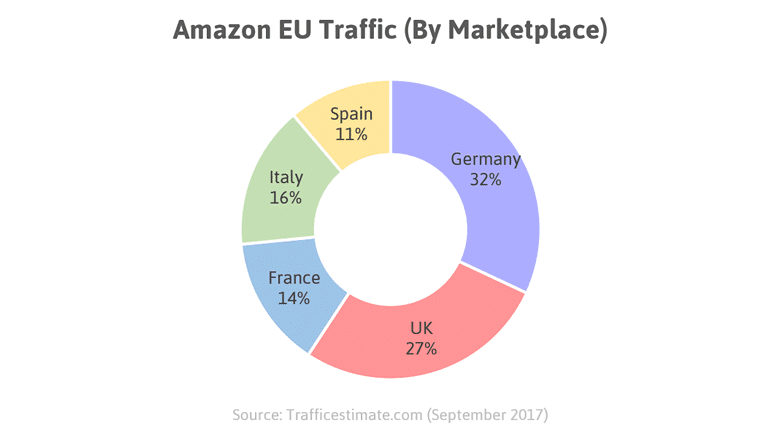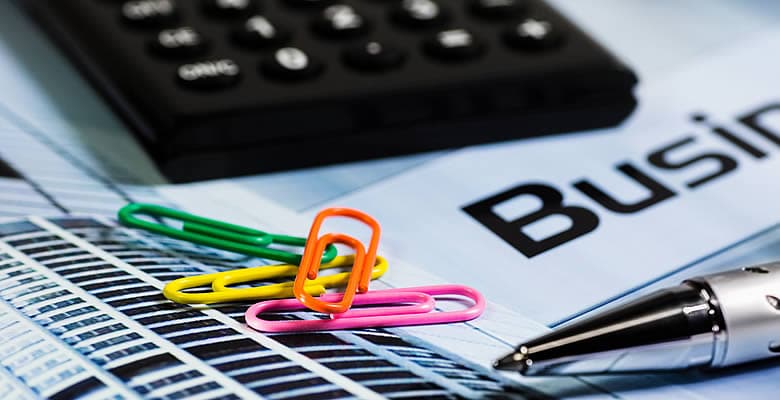This post is by David Barry, co-founder of AMZ Europe.
Selling on Amazon’s European marketplaces is tough for US sellers. There’s VAT to deal with, different currencies, different languages and the small matter of getting your stock into Europe. But if you successfully overcome these challenges, expanding to Amazon Europe can be the best option for US sellers looking to grow their business internationally.
Why? Because it is Amazon’s biggest international market. Last year, Germany and the UK accounted for more than half of Amazon’s international sales. This could increase over the coming years, as online sales in Europe are primed for significant growth.
The EU also offers favorable market conditions to sellers, with more potential customers and fewer sellers than the US. This means that businesses who sell on Amazon Europe have a great opportunity to gain a large market share.
Let’s examine the key issues for sellers who want to expand to Europe.
Key issues for US sellers selling on Amazon Europe
1. Where to sell?
Many sellers start out by selling only on Amazon UK. By doing so, you’ll be missing out on almost 70% of the European market and significantly limiting your potential sales.

Germany is a bigger marketplace than the UK, so selling there should be a no-brainer. While the three other marketplaces (France, Italy and Spain) are smaller, they are growing fast and are home to 174 million more potential customers for your products.
The competition in these countries is also lower, both in terms of the number of sellers and the quality of listings you’ll be up against. This can make these marketplaces highly profitable for sellers.
As such, sellers should list their products and sell on all five Amazon Europe marketplaces to maximize their potential sales in Europe. I have a close friend who took this advice and now his most profitable marketplaces are Amazon France and Italy.
Selling on non-English speaking marketplaces
According to Web Retailer, almost half (229) of the top 500 Amazon Sellers in Europe sell in only one of the five EU Marketplaces! The language barrier clearly exists and deters many sellers from expanding outside their home marketplace.
Despite this, for English speaking sellers, selling in the non-English speaking EU marketplaces is not complicated. Your UK seller account can be used for all five marketplaces, and all orders can be fulfilled from inventory stored in the UK, using Amazon’s European Fulfillment Network (discussed in greater detail in section five below).
Translating your listings to the local language is the only step initially, and there is no extra cost to list on these marketplaces. However, many sellers don’t do a good job at translating, and adapting their product listings to non-English speaking marketplaces, which we’ll discuss next.
2. Listing your products
It is important to note that in each market you will be competing against local sellers and businesses. In order to compete effectively, it is critical that your listings are optimized for the customers in each country. For non-English listings, many sellers just hire a freelancer online to translate their listings.
However, your listings should not just be translated, but also localized. Localization is a blend of copywriting and translation, which produces sales copy that is tailored and adapted to the local market. The goal is conversion, not just translation.
Keyword research
It’s also crucial that comprehensive keyword research is performed in each language. This will help you identify the best keywords in each target language – those which customers use to find a product like yours. You should then include these keywords in your listing and backend search terms.
Failure to do keyword research in the local language is one of the biggest reasons why sellers struggle on Amazon’s non-English speaking marketplaces. It should be done before your sales copy is localized, as the top keywords identified should be naturally integrated into your listing during localization.
If English is your first language and you’re selling on non-English speaking marketplaces, you should hire native speakers, with ecommerce experience, to do your keyword research. A native’s comprehensive vocabulary will be indispensable for finding the best keywords for your products.
Furthermore, a native speaker will ensure that only keywords relevant to your product are included. Non-relevant keywords will result in traffic from customers who are not searching specifically for a product like yours, and will likely hurt your conversion rate.
You may be tempted to just translate your English keywords, but this is not advisable, as some languages have a much richer vocabulary than English. Without doing the research part, you will miss some keywords. If these are high volume and relevant keywords, this can significantly reduce your traffic and sales. Direct translation of a keyword from English into another language also often produces a phrase that has a totally different meaning than intended.
If you need help with your EU listings, look for a service which offers detailed keyword research and localization, as well as translation.
3. Do you need to set up a new company?
Amazon Europe has a list of accepted countries for seller registration. If you are registered under one of these countries and selling on Amazon.com you can sell on Amazon Europe using your existing company. Most US sellers have a US company, and that’s fine for selling on Amazon Europe. This is the most straightforward option when getting started.
There are some sellers who opt to incorporate a new company for their EU operation, but this is not necessary when starting out. It will result in extra costs, including incorporation fees and annual costs to maintain the new company, like professional fees for accounting and tax reporting.
4. Understanding & managing VAT
In my experience, Value Added Tax (VAT) is one of the biggest barriers that prevents US sellers from expanding to Europe. The complexity of VAT is certainly overstated. It’s quite similar to sales tax in the US and by working with the right accountant, it’s easy to take care of.

So what is VAT?
VAT is a consumption tax that is applied to transactions involving goods and services sold in Europe. Here is a very simple example to illustrate how it works for sellers:
- A seller in the UK plans to sell a product for £100. A 20% VAT rate applies in the UK – this must be added to the price of the product when sold. And so, the retail price will be £120 (£100 plus 20% VAT).
- A buyer pays £120 to acquire this product from the seller.
- The seller will keep £100, while the VAT portion of the sale (£20) must be passed on to the UK government by the seller as part of their next VAT return.
There are two circumstances where you need to register for and charge VAT in a particular country in Europe:
- Country of storage rule: If you keep your inventory in a country in Europe, you need to register for VAT there.
- Sales threshold rule: When you reach a predetermined level of sales to customers in a particular country in a calendar year.
New EU Sellers
For US sellers who are expanding to Amazon Europe, I recommend sending and storing all of your inventory in the UK. As a result, VAT registration will be required in just one country (the UK) at the outset.
Ultimately, VAT is a tax that needs to be accounted for in your pricing and, like other taxes, returns must be filed and the tax paid over at the right time. To ensure you focus on what you do best (growing your business), it is advisable to consult an expert to get this set up correctly and managed going forward.
5. The best fulfillment strategy when starting out
There are three FBA models that new EU sellers can choose from. One of them is known as “Pan-European FBA”. If you opt for this, your inventory can be stored in any of Amazon’s European warehouses across seven countries – the UK, Germany, France, Italy, Spain, Poland and Czech Republic.
This is closely aligned with Amazon’s interests, because it allows them to place products as close to customers as possible, which reduces delivery times and shipping costs.
However, Pan-EU FBA is not optimal for new EU sellers in my opinion. Due to the country of storage rule, you will need to register for VAT and make regular VAT returns in seven different countries. For a new EU seller, this is quite a significant expense, both upfront (for VAT registration) and going forward (filing VAT returns).
Amazon’s European Fulfillment Network (“EFN”) is a better option for those starting out. By selecting this as your Amazon Europe fulfillment method, all of your inventory will be shipped to and stored in the UK. As such, you’ll just have to register for VAT in one country to start with.
Importantly, you’ll still be able to list your products on the other Amazon Europe marketplaces (Germany, France, Italy and Spain) and sell to customers throughout Europe. When orders are made on these marketplaces for your products, they will be shipped by Amazon from the UK.
6. Importing products into the UK
Getting started
By shipping all of your inventory to the UK, you can simplify your logistics when starting out. It will also be more cost efficient.

To import products into the UK or Europe, you’ll need to apply for an an Economic Operator Registration and Identification Number (EORI). Most of the time this is provided when you register for UK VAT and get your VAT number.
Import duties and taxes
When shipping products to a new country, the issue of customs and duties always comes up. It can be difficult to determine what extra fees your products will be subject to upon importation. When importing into the UK, you need to be be aware of:
Import duties
- Generally speaking, the duties you pay will be based on the cost of your goods (including shipping) and the duty rate for your particular products.
- This is a non-refundable cost that you need to account for.
Import VAT
- Import VAT is typically 20% of the cost of your products (including shipping and duties).
- This is refundable, because the VAT you are charged here can be offset against the VAT collected on your sales to UK consumers
The above is a brief summary of UK import duties and taxes, and should not be considered a definitive guide. Aligning with a service provider who has experience importing to the EU and preparing products for Amazon Europe is recommended, particularly for your first few shipments. They can assist you with labeling too, which we’ll look at next.
Labeling
When a seller wants to list a new product on Amazon.com, they provide a UPC barcode number, which generates an FNSKU code on Amazon. FNSKU labels must be placed on each item that sellers send into Amazon FBA. They allow Amazon to track inventory and ensure you get credit for all of your sales.
To generate FNSKU labels for Amazon Europe, you will need to provide an EAN barcode number. There are a number of companies that sell these online at a low cost. Many times when you buy a UPC barcode, you’ll also receive a corresponding EAN barcode.
7. Dealing with foreign currencies and getting paid
For most US sellers, expanding to Amazon Europe will represent the first time that their business has had to deal with foreign currencies. Your sales will be in pounds (£) on Amazon UK and euros (€) for the other marketplaces (Germany, France, Italy and Spain).
Most US sellers that are new to Europe will link their Amazon Europe seller account to a US bank account. Amazon will then automatically convert the pounds and euros you receive into USD and then transfer this amount to your US bank account.
In the process of converting your funds, Amazon typically charges sellers around 3% to 4% in exchange fees. For larger sellers, and those operating under tight profit margins, this can be a significant cost and hurt your bottom line.
I advise new EU sellers to set up an account with an ecommerce currency exchange service. This will allow you to lower your exchange fees and keep more of your profits. It’s also a cheaper and more convenient option than opening up a new bank account in Europe.
In closing
Overall, the benefits of expanding to Europe are very enticing for US sellers:
- Introducing your products to millions of new customers.
- Selling on five marketplaces that are less competitive than Amazon.com and offer significant growth potential.
- Allowing you to leverage successful products and supplier relationships you have already put in place.
Key takeaways to help your business get started on Amazon Europe:
- To minimize initial costs and simplify your initial dealings with VAT, ship all of your inventory to the UK.
- To maximize sales, list your products in each of the five Amazon Europe Marketplaces. Orders outside the UK can be fulfilled using Amazon’s European Fulfillment Network.
- Non-English listings must be localized, not just translated. Comprehensive keyword research is essential.
- Set up an account with a payment solutions provider to reduce exchange fees and keep more of your profits.
If you have any questions, you can leave a comment below or get in touch through the AMZ Europe website.
This post was by David Barry, co-founder of AMZ Europe, an ecommerce agency which helps retailers and brands sell on Amazon’s European marketplaces. AMZ Europe has a free guide to help businesses assess their sales potential in Europe.

Hi all, hope you like my post! Feel free to comment here if you have any questions.
Best,
David